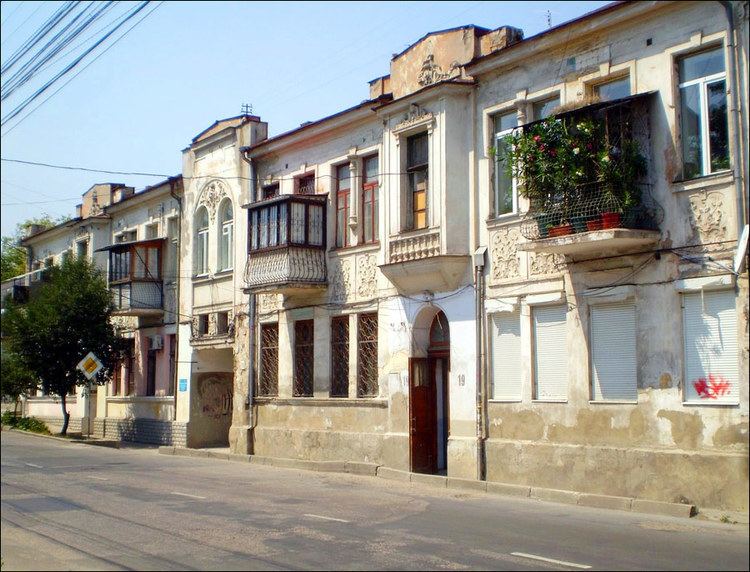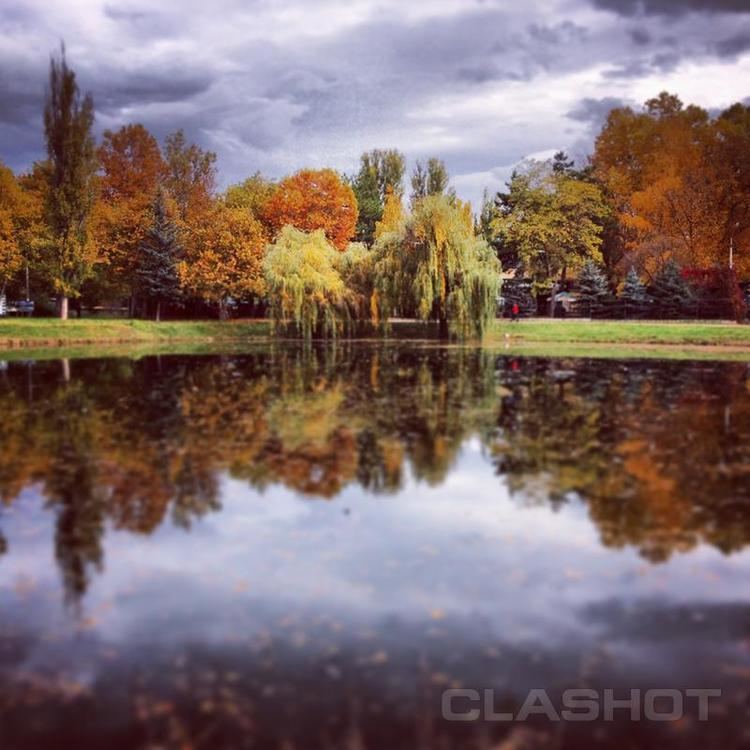Country RussiaUkraine Area 107 km2 Founded 1784 | Population 330,981 (2011) Region Simferopol municipality | |
 | ||
Colleges and Universities Tavrida National V.I. Vernadsky University | ||
Map of Simferopol
Simferopol (; Russian: Симферополь; [sʲɪmfʲɪˈropəlʲ]; Ukrainian: Сімферополь, [sʲimfɛˈrɔpɔlʲ]; Crimean Tatar: Aqmescit, Акъмесджит) is a city on the Crimean peninsula, the status of which is disputed between Ukraine and Russia. As a result of 2014 vote to join Russia, which was held during Russian military intervention, and the subsequent annexation of Crimea by the Russian Federation, Simferopol has been the de facto administrative centre of the Republic of Crimea, though it remains the de jure capital of the Autonomous Republic of Crimea. Simferopol is an important political, economic, and transport hub of the peninsula and serves as the administrative center of both Simferopol municipality and Simferopol Raion though it does not belong to the raion. Population: 332,317 (2014 Census).
Contents
- Map of Simferopol
- Etymologies
- Early history
- Russian Empire and Civil War
- World War II
- After Ukrainian independence
- After Russian annexation
- Location
- Climate
- Politics and administrative divisions
- Transportation
- Demographics
- Economy
- Industry
- Education
- Sports
- Twin towns Sister cities
- References

Archaeological evidence in Simferopol indicates the existence of an ancient Scythian city, collectively known as the Scythian Neapolis. The location was also home to a Crimean Tatar town, Aqmescit. After the annexation of the Crimean Khanate to the Russian Empire, the city's name was changed to its present Simferopol.

Etymologies
The name comes from the Greek Sympheropolis (Greek: Συμφερόπολις, Symferópolis), meaning city of common good. It is spelled Simferopol (Ukrainian: Сімферо́поль; Russian: Симферо́поль [sʲɪmfʲɪˈropəlʲ]) or Symferopil (Ukrainian: Симферопіль).
In Crimean Tatar, the name of the city is Aqmescit, which means The white mosque (Aq—white, and mescit—mosque). In English, the name was often given as Akmechet or Ak-Mechet (e.g. in Encyclopædia Britannica), a transliteration from Russian Акмечет, Ак-Мечеть, where Mechet (Мечеть) is the Russian word for "mosque".
Early history
Archaeological evidence in the Chokurcha cave shows the presence of ancient people living in the territory of modern Simferopol. The Scythian Neapolis, known by its Greek name, is also located in the city, which is the remnants of an ancient capital of the Crimean Scythians who lived on the territory from the 3rd century BC to the 4th century AD.
Later, the Crimean Tatars founded the town of Aqmescit. For some time, Aqmescit served as the residence of the Qalğa-Sultan, the second most important position in the Crimean Khanate after the Khan himself.
Russian Empire and Civil War
The city was renamed Simferopol in 1784 after the annexation of the Crimean Khanate to the Russian Empire by Catherine II of Russia. The name Simferopol is in Greek, Συμφερόπολις (Simferopolis), and literally means "the city of usefulness." The tradition to give Greek names to places in newly acquired southern territories was carried out by Empress Catherine the Great as part of her Greek Plan. In 1802, Simferopol became the administrative centre of the Taurida Governorate. During the Crimean War of 1854–1856, the Russian Imperial Army reserves and a hospital were stationed in the city. After the war, more than 30,000 Russian soldiers were buried in the city's vicinity.
In the 20th century, Simferopol was once again affected by wars and conflicts in the region. At the end of the Russian Civil War, the headquarters of General Pyotr Wrangel, leader of the anti-Bolshevik White Army, were located there. On 13 November 1920, the Red Army captured the city and on 18 October 1921, Simferopol became the capital of the Crimean Autonomous Soviet Socialist Republic.
World War II
During World War II, Simferopol was occupied by Nazi Germany from 1 November 1941 to 13 April 1944. Retreating NKVD police shot a number of prisoners on 31 October 1941 in the NKVD building and the city's prison. Germans perpetrated one of the largest war-time massacres in Simferopol, killing in total over 22,000 locals—mostly Jews, Russians, Krymchaks, and Gypsies. On one occasion, starting 9 December 1941, the Einsatzgruppen D under Otto Ohlendorf's command killed an estimated 14,300 Simferopol residents; most of them were Jews.
In April 1944, the Red Army liberated Simferopol. On 18 May 1944 the Crimean Tatar population of the city along with the whole Crimean Tatar nation of Crimea was forcibly deported to Central Asia in a form of collective punishment. On 26 April 1954 Simferopol, together with the rest of the Crimean Oblast, was transferred from the Russian Soviet Federative Socialist Republic to the Ukrainian Soviet Socialist Republic by Soviet Premier Nikita Khrushchev.
An asteroid 2141 Simferopol discovered in 1970 by Soviet astronomer Tamara Mikhailovna Smirnova is named after the city.
Following a referendum on 20 January 1991, the Crimean Oblast was upgraded an Autonomous Soviet Socialist Republic on 12 February 1991 by the Supreme Soviet of the Ukrainian SSR. Simferopol became the capital of the Crimean Autonomous Soviet Socialist Republic.
After Ukrainian independence
After the collapse of the Soviet Union in 1991, Simferopol became the capital of the Autonomous Republic of Crimea within newly independent Ukraine. Today, the city has a population of 340,600 (2006) most of whom are ethnic Russians, with the rest being Ukrainian and Crimean Tatar minorities.
After the Crimean Tatars were allowed to return from exile in the 1990s, several new Crimean Tatar suburbs were constructed, as many more Tatars returned to the city compared to number exiled in 1944. Land ownership between the current residents and returning Crimean Tatars is a major area of conflict today with the Tatars requesting the return of lands seized after their deportation.
On 16 March 2014, a referendum was held whose results showed that a majority of Crimeans voted in favour of independence of Crimea from Ukraine and joining Russia as a federal subject. The legitimacy of the referendum's results has been questioned by several nations and independent news organizations. On 21 March, Simferopol officially became the capital of a new federal subject of the Russian Federation. The referendum was not recognized internationally, and the event was viewed by many as an annexation of the Crimean land by the Russian Federation.
After Russian annexation
On 14 September 2014, a municipal election was held, which was its first ever parliamentary election since the Crimean status referendum of 16 March 2014 (which was a part of the wider annexation process). During the first session, the Simferopol City Council appointed Gennady Bakharev to the position of the acting Head of the Simferopol Administration nt mayor Viktor Ageyev was appointed Chairman of Simferopol City Council and de facto kept his position as the Mayor of Simferopol.
Location
Simferopol is located in the south-central portion of the Crimean Peninsula. The city lies on the Salhir River and near the artificial Simferopol Reservoir, which provides the city with clean drinking water. The Simferopol Reservoir's earth dam is the biggest in Europe.
Climate
The city experiences a humid subtropical or oceanic climate (depending on which version of the Köppen climate classification is used), near the boundary of the humid continental climate. The average temperature in January is 0.2 °C (32.4 °F) and 22.3 °C (72.1 °F) in July. The average rainfall is 514 millimetres (20.2 in) per year, and there is a total of 2,471 hours of sunshine per year.
Politics and administrative divisions
As the capital of the Republic, Simferopol houses its political structure including the Parliament and the Council of Ministers. Simferopol is also the administrative centre of the Simferopolskyi Raion (district), however, it is directly subordinate to the Crimean authorities rather than to the raion authorities housed in the city itself.
The city of Simferopol is administratively divided into three raions (Zaliznychnyi, Tsentralnyi, and Kyivskyi), four urban-type settlements (Ahrarne, Aeroflotskyi, Hriesivskyi, Komsomolske) and one village (Bitumne). The city's mayor is (since the 2010 Ukrainian local elections) Viktor Ageev from the Party of Regions. The previous mayor, Henadiy Babenko, was also (when elected) a member of Party of Regions; but he was expelled from that party in September 2009.
Transportation
Simferopol has a major railway station, which serves millions of tourists each year. In December 2014 Ukraine cut the railway line to Crimea at the border. Currently, the station serves only a commuter (regional) passenger train and the Moscow – Simferopol train every day.
The city is also connected via the Simferopol International Airport, which was constructed in 1936. Zavodskoye Airport is situated southwest of Simferopol.
The city has several main bus stations, with routes towards many cities, including Sevastopol, Kerch, Yalta, and Yevpatoriya. The Crimean Trolleybus connects Simferopol to the city of Yalta on Crimean Black Sea coast. The line is the longest trolleybus line in the world with a total length of 86 kilometres (53 mi) (since 2014 again 96 kilometres (60 mi)).
The streets of Simferopol have a rare house numbering – the odd numbers are on the right side of the road, looking in the direction in which the numbers increase.
Demographics
As of the Ukrainian National Census, 2001, Simferopol's population is 363,600. According to the census, Russians constitute 66.7% of the total population, Ukrainians 21.3%, Crimean Tatars 7%, Belarusians 1.1%, Jews 0.7%, Armenians 0.6%.
Economy
When it existed, Crimea Air had its head office on the grounds of Simferopol Airport. Simferopol hosts some industries, such as 'Zavod 'Phiolent' JSC producing Marine automation control systems; Precise electrical micro machines of low input power; Power tools, for both professional and household usage.
Industry
Education
The largest collection of higher education institutions in Crimea is located in Simferopol. Among them is the largest university in Simferopol and Crimea, the Taurida V.Vernadsky National University, which was founded in 1917. Crimea State Medical University named after S. I. Georgievsky, also located in Simferopol, is one of the most prominent medical schools of Ukraine. The Crimean Medical University is situated on the plot, where in 1855 a nursery garden was planted by the founder of the Nikita Botanical Gardens Ch.Ch.Steven (1781–1863). In 1863–66 a school for girls was built here and in 1931 a medical institute was opened. On the same plot P.Krzhizhanovsky built a three-storey hostel for medical students after the design in 1934. The building with clear geometric masses was completed in 1938.
Sports
Simferopol is home to the football club Tavriya Simferopol, who were the first champion in the history of the Ukraine Premier League, and also won the Ukrainian Cup in 2010. After the 2014 Crimean Conflict, the club ceased its existence and applied for a Russian license, and with the new name FC TSK Simferopol. It currently plays in the Crimean Premier League.
Twin towns – Sister cities
Simferopol is currently twinned with:
